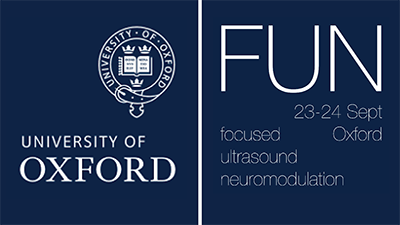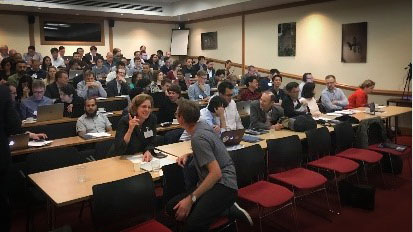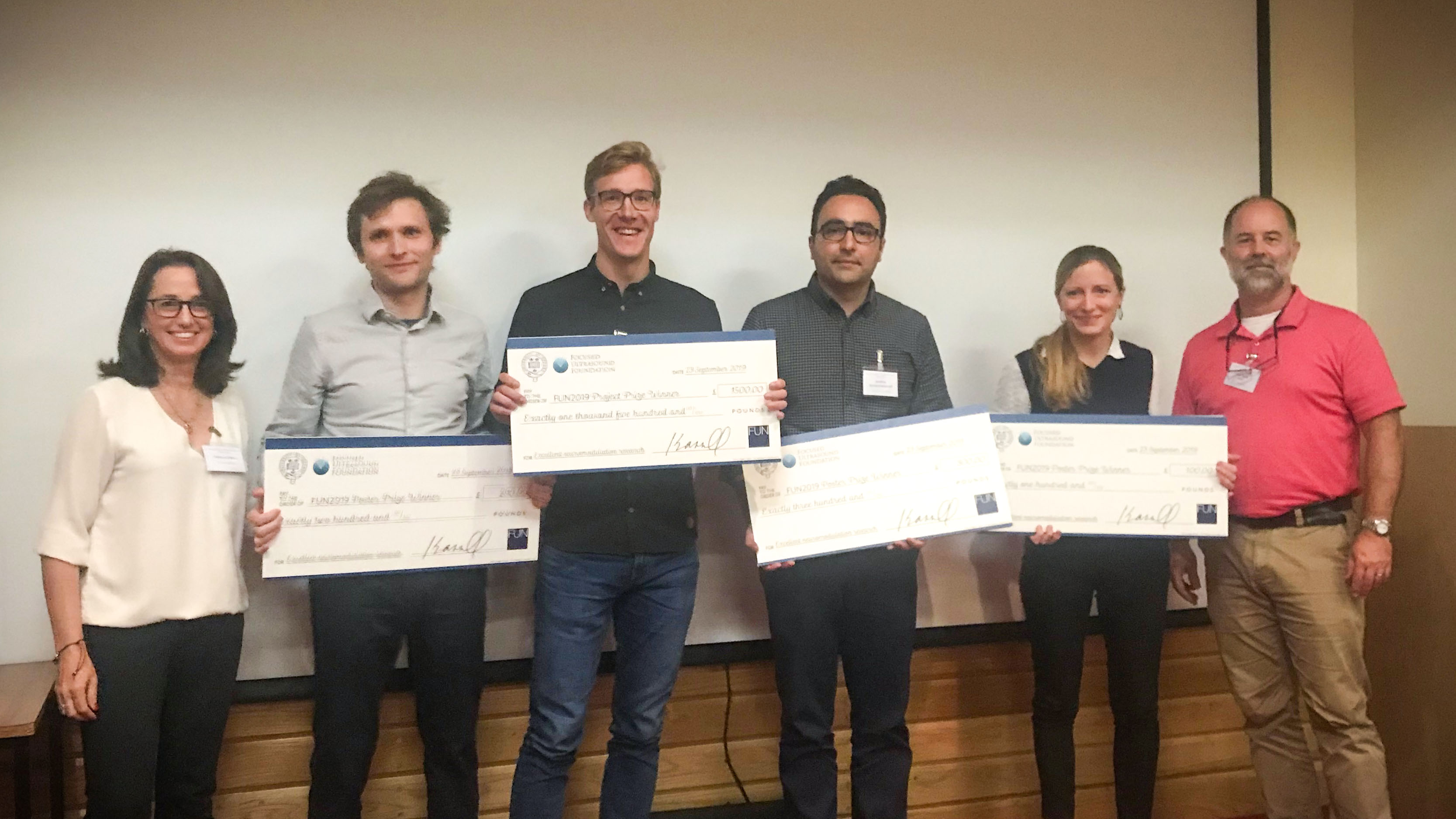 The first Focused Ultrasound Neuromodulation (FUN) Symposium was held in Oxford, England, on September 23-25.
The first Focused Ultrasound Neuromodulation (FUN) Symposium was held in Oxford, England, on September 23-25.
More than 120 leading researchers across varied disciplines, including engineers, physicists, neurobiologists, neurobehavioralists, psychologists, and clinicians, traveled to Oriel College at Oxford University. Many others watched via live streaming.
Four Oxford researchers organized the meeting: Jerome Sallet, PhD, Charlotte Stagg, MRCP, DPhil, Antoine Jerusalem, PhD, MSc, and Lennart Verhagen, PhD.
Neuromodulation involves using focused ultrasound to stimulate or suppress neural activity, depending on the parameters of the energy applied to the tissue. The presentations and posters featured neuromodulation research focusing on the mechanisms of action, technical parameters, and significant preclinical data. A few early translational clinical studies with neuromodulation were also discussed.
In addition to the manufacturing of numerous transducers from individual sites, additional neuromodulation devices were highlighted from new companies such as Sonic Concepts and Neurosona.
Attendees at the meeting also agreed to use the abbreviation TUS (transcranial ultrasound stimulation) as an umbrella term under which multiple mechanisms, such as neuromodulation and low-intensity focused ultrasound for blood-brain barrier opening, could be categorized.
The meeting was sponsored by the Focused Ultrasound Foundation, the Engineering and Physical Sciences Research Council, FUS Instruments, Rogue Research, Sonic Concepts, Verasonics, and the Wellcome Center for Integrative Neuroimaging.
 Technical and Preclinical Work
Technical and Preclinical Work
Over the first two days, technical presentations centered on important contributions leading to a better understanding of the underlying biomechanical phenomena involved in eliciting neuromodulatory effects with ultrasound. Several groups are also pursuing computational modeling of these phenomena. Issues surrounding the reproducibility of neuromodulation simulations and experiments were discussed as well as the necessity for defining a robust concept of dose. Correcting for the aberration of ultrasound by the skull and verification of the targeted spot within the brain using MR imaging were also presented.
Current results of several preclinical projects across a range of animal models were presented. Investigated preclinical neuromodulation topics included motor skill enhancement, visual pathway modulation, brain plasticity modulation, memory formation, sensory discrimination, learning, and decision making.
Emerging Clinical Data
Early first-in-human clinical trials are now exploring the potential benefits of neuromodulation. An original case report (Brain Stimulation 9 (2016) 940–941) described a patient with improvement in their coma recovery and demonstrated improved language and communication, which inspired a larger study. A presentation by Martin Monti from the University of California Los Angeles entitled, “Subcortical low intensity ultrasound disorders of consciousness,” discussed these early promising results with improved outcomes compared to historic control cohort when targeting the thalamus with low-intensity pulsed focused ultrasound.
Earlier research with disorders of consciousness involved invasive deep brain stimulation (DBS) procedures and transcranial direct current stimulation (tDCS) that did not penetrate deep into the brain. Thus, noninvasive neuromodulation with ultrasound to these deeper areas may prove clinically useful.
A poster from Brigham and Women’s Hospital entitled, “Hippocampal low- intensity transcranial focused ultrasound neuromodulation for drug-resistant epilepsy: Initial experience with a single human subject,” reported on part of a 10-patient study for treatment of epilepsy due to mesial temporal sclerosis. In these cases, neuromodulation with transcranial ultrasound could prove to be an important noninvasive treatment alternative compared to invasive surgeries.
Next Steps
On the third day of the meeting, a select group of approximately 25 attendees formally discussed the steps necessary to accelerate preclinical research and progress toward clinical adoption. Attendees established several international working groups to provide guidance and expertise in the following areas:
- Create universal phantom simulations
- Establish biologic safety values and differentiate dose versus exposure
- Consider which types of health care professionals can perform clinical neuromodulation procedures
- Evaluate the effects of anesthesia on neuromodulation studies
- Report data on histology and behavioral testing
- Standardize data reporting
- Research immune effects with TUS
- Evaluate whether air bubbles affect studies and the possible need for hair removal
- Decide date/location of next Focused Ultrasound Neuromodulation meeting
- Publish a consensus and discussion paper in a special issue of the journal NeuroImage
 Research Prizes
Research Prizes
To promote important research in neuromodulation, the Focused Ultrasound Foundation sponsored the following awards:
First prize poster
Transcranial Focused Ultrasound Neuromodulation of the Thalamic Visual Pathway in a Large Animal Model
Authors: Morteza Mohammadjavadi, Pooja Gaur, Jan Kubanek, Yamil Saenz, Gary H. Glover, Gerald R. Popelka, Anthony Norcia, Kim Butts Pauly
Institution: Stanford University, Stanford, CA, USA
Second prize poster
Acoustically Targeted Chemogenetics for Noninvasive Control of Neural Circuits
Authors: Jerzy Szablowski, Audrey Lee-Gosselin, Brian Lue, Dina Malounda, John Heath, Mikhail Shapiro
Institution: California Institute of Technology, Pasadena, CA, USA
Third prize poster
The Macaque Anterior Cingulate Cortex Translates Counterfactual Choice Value into Actual Behavioral Change
Authors: E Fouragnan, BKH Chau, D Folloni, N Kolling, L Verhagen, M Klein-Flügge, L Tankelevitch, GK Papageorgiou, JF Aubry, J Sallet, MFS Rushworth
Institutions: University of Plymouth, Plymouth, UK; University of Oxford, Oxford, UK; The Hong Kong Polytechnic University, Hong Kong, China; Massachusetts Institute of Technology, Cambridge, MA, USA; ESPCI Paris, CNRS, PSL Research University, Paris, France
Project winner
Diffusion Tractography-guided Neuronavigation for Focused Ultrasound Neuromodulation of Human Cortical White Matter Tracts
Author: Olof van der Werf
Institution: Maastricht University, Maastricht, Netherlands
